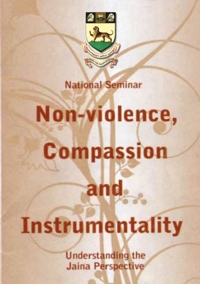 | Non-violence, Compassion and InstrumentalityA Jaina PerspectiveSeminar organized by the Department of Jainology of the University of Madras, 13 and 14 February 2009 Chennai, India |
14.02.2009
2.01 Compassion
Introduction
Compassion is a very basic and inherent quality of our Ātmā. Since childhood we have been taught by our parents, teacher, elders that we should be compassionate with everyone, that we should sympathize and empathize with all living beings, that we should not hurt or harm others. And we all have made an effort and continue to strive to inculcate and implement this quality of our Ātmāi in some or the other way.
For example: If my sister is sad or depressed since she had a fight with her friend, I will be concerned and compassionate towards her. Similarly if my friend has lost a job I am surely going to feel bad for her, or if there is a death in my neighborhood I am likely to console my neighbors. We can relate many such incidences in our lives since we all have experienced this feeling of compassion at some time or the other.
Levels of compassion
Now let us analyze whether we have the same degree of compassion at all times with all people. For example my loving friend for whom I care a lot and I have been with her through all her difficult times happens to betray me for some reason. Then what happens to my feelings of compassion, concern, and love towards her? Will I be equally affectionate as I was during her difficult times? The answer is NO. I will think, how can I be positive with her when she has done something wrong to me? The reason behind my negative reaction towards her is because I am the victim of the circumstance here. We all experience this in our day to day life. Our feelings towards a person are subject to their behavior with us. It changes from situation to situation. And the result is the continuous positive and negative feelings in a relationship.
Compassion with the Instrument
Here the instrument is nothing but the Nimit, what we perceive to be the reason of anything that happens to us. If we develop harmony with the instrument then the negative element in our relationships goes on diminishing and the relationship becomes more and more positive. This makes life more beautiful for us and the people around us.
Hierarchy of a relationship
1.Negative-Negative
Typically this is the situation which we face most often. It means that when one person is negative, the other also tends to be negative. For example if a person gets angry with us we will also tend to react negatively thereby creating more rift with the instrument.2. Negative-Positive
Ideally we should aim for this since here we start being positive in spite of the instrument being negative3. Positive-Positive
This is the most ideal and is the result of being positive to the instrument in all situations. It happens when our positive waves collide with the negative waves of the instrument and slowly the negative from the opposite side also changes into positive.
Means to achieve positive-positive
Gandhiji’s famous quote, “The best way to defeat your enemy is to make him your friend”. But how to achieve this is a million dollar question!
The most important factor for applying the above mentioned measures in our lives is we should strongly believe that I AM THE SOUL. The more we believe the more we will be able to relate to the qualities of the soul and slowly these qualities that are naturally ingrained in us, will start giving results. Again this strong belief and faith in ourselves can be achieved through the preaching of an enlightened teacher who has experienced the qualities of the soul in depth. By unconditional love and devotion towards such a learned soul, we can also liberate our soul from all the bondages.
 Dharini Botaddra
Dharini Botaddra